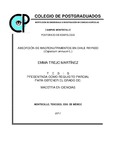| dc.contributor.author | Trejo Martínez, Emma | |
| dc.creator | TREJO MARTÍNEZ, EMMA; 639256 | |
| dc.date.accessioned | 2019-08-30T18:30:10Z | |
| dc.date.available | 2019-08-30T18:30:10Z | |
| dc.date.issued | 2017-10 | |
| dc.identifier.uri | http://hdl.handle.net/10521/3930 | |
| dc.description | Tesis (Maestría en Ciencias, especialista en Edafología).- Colegio de Postgraduados, 2017. | es_MX |
| dc.description.abstract | El chile rayado es endémico de la huasteca, en el municipio de la Misión en el estado de Hidalgo, este cultivo representa una fuente importante de ingresos económicos para la población y del cual hay poca información técnica. Por tanto, esta investigación tuvo como objetivo determinar la absorción nutrimental a lo largo de su ciclo. Se usaron cuatro concentraciones de la solución nutritiva Steiner (50, 75, 100 y 125%), para ver su efecto en el crecimiento de la planta y en el contenido de capsaicina en fruto. Como medio de cultivo se utilizó una mezcla de tezontle y fibra de coco. Se usó un diseño completamente al azar con tres repeticiones. Los resultados muestran que ninguna de las concentraciones fue mejor que otra en cuanto al crecimiento de las plantas, sin embargo, las plantas al final del ciclo tuvieron una altura mayor (170 cm) a las producidas localmente (40 a 90 cm). En cuanto a la absorción nutrimental, en general, en orden decreciente fue: K, N, Ca, Mg, P y S. El mayor contenido (%) de K fue de 4.41, la de N 4.40, la de Ca 1.32, la de Mg 1.14, la de P 0.41 y para el S fue de 0.15. El contenido de capsaicina no fue afectada por las concentraciones de la solución nutritiva, no obstante el mayor contenido de este alcaloide se obtuvo en frutos de plantas regadas con solución al 50 y 75%; 76,365 y 83,145 unidades Scoville de picor respectivamente. Estas categorías superan al del chile jalapeño y se ubican en la del chile manzano y piquín. _______________ NUTRIENT ABSORPTION IN STRIPED CHILE (Capsicum annuum L.). ABSTRACT: Striped chile is endemic to the Huasteca region, in the municipality of La Mision in the state of Hidalgo. This crop represents an important source of income for the population, there being little technical information on the crop. Therefore, the present research work had the objective of determining the nutrient absorption throughout its life cycle. Four concentrations of the Steiner nutrient solution (50, 75, 100, and 125%) were used in order to learn its effect on plant growth and capsaicin content in the fruit. A mixture of tezontle (porous volcanic rock) and coconut fiber was used as growth medium. A completely randomized design with three replicates was used. The results show that none of the concentrations was better than the rest regarding to plant growth; however, at the end of the cycle, the plants were taller (170 cm) than those grown locally (40 to 90 cm). With regard to nutrient absorption, it was in decreasing order: K, N, Ca, Mg, P, and S. The highest concentrations (%) were as follows: K 4.41, N 4.40, Ca 1.32, Mg 1.14, P 0.41, and S 0.15. The capsaicin concentration was not affected by the concentrations of the nutrient solution, regardless, the highest concentrations of this alkaloid were obtained in fruits with the solution at 50 and 75%; 76,365 and 83,145 Scoville units, respectively. These category values are higher than those of jalapeño pepper, reaching those of manzano and piquin peppers. | es_MX |
| dc.description.sponsorship | Consejo Nacional de Ciencia y Tecnología (CONACyT). | es_MX |
| dc.format | pdf | es_MX |
| dc.language.iso | spa | es_MX |
| dc.rights | Atribución-NoComercial-SinDerivadas 2.5 México | * |
| dc.rights.uri | http://creativecommons.org/licenses/by-nc-nd/4.0 | es_MX |
| dc.subject | Capsaicina | es_MX |
| dc.subject | Unidades Scoville de picor | es_MX |
| dc.subject | Macronutrientes | es_MX |
| dc.subject | Hidroponía | es_MX |
| dc.subject | Capsaicin | es_MX |
| dc.subject | Scoville units | es_MX |
| dc.subject | Hydroponics | es_MX |
| dc.subject | Macronutrients | es_MX |
| dc.subject | Edafología | es_MX |
| dc.subject | Maestría | es_MX |
| dc.subject.classification | CIENCIAS AGROPECUARIAS Y BIOTECNOLOGÍA::CIENCIAS AGRARIAS::AGRONOMÍA::FISIOLOGÍA VEGETAL | es_MX |
| dc.title | Absorción de macronutrimentos en chile rayado (Capsicum annuum L). | es_MX |
| dc.type | Tesis | es_MX |
| Tesis.contributor.advisor | Ordaz Chaparro, Víctor Manuel | |
| Tesis.contributor.advisor | Sandoval Villa, Manuel | |
| Tesis.contributor.advisor | Galvis Spinola, Arturo | |
| Tesis.contributor.advisor | Becerril Román, Alberto Enrique | |
| Tesis.date.submitted | 2017-10 | |
| Tesis.date.accesioned | 2017 | |
| Tesis.date.available | 2017 | |
| Tesis.format.mimetype | pdf | es_MX |
| Tesis.format.extent | 1,276 KB | es_MX |
| Tesis.subject.nal | Absorción de nutrientes | es_MX |
| Tesis.subject.nal | Nutrient uptake | es_MX |
| Tesis.subject.nal | Soluciones nutritivas | es_MX |
| Tesis.subject.nal | Nutrient solutions | es_MX |
| Tesis.subject.nal | Valor nutritivo | es_MX |
| Tesis.subject.nal | Nutritive value | es_MX |
| Tesis.subject.nal | Crecimiento de planta | es_MX |
| Tesis.subject.nal | Plant growth | es_MX |
| Tesis.subject.nal | Alcaloides | es_MX |
| Tesis.subject.nal | Alkaloids | es_MX |
| Tesis.subject.nal | Fenología | es_MX |
| Tesis.subject.nal | Phenology | es_MX |
| Tesis.subject.nal | Montecillo, Texcoco, Estado de México, México | es_MX |
| Tesis.rights | Acceso abierto | es_MX |
| Articulos.subject.classification | Capsicum annuum | es_MX |
| dc.type.conacyt | masterThesis | es_MX |
| dc.identificator | 6||31||3103||241719 | es_MX |
| dc.contributor.director | ORDÁZ CHAPARRO, VÍCTOR MANUEL; 10824 | |
| dc.audience | generalPublic | es_MX |


